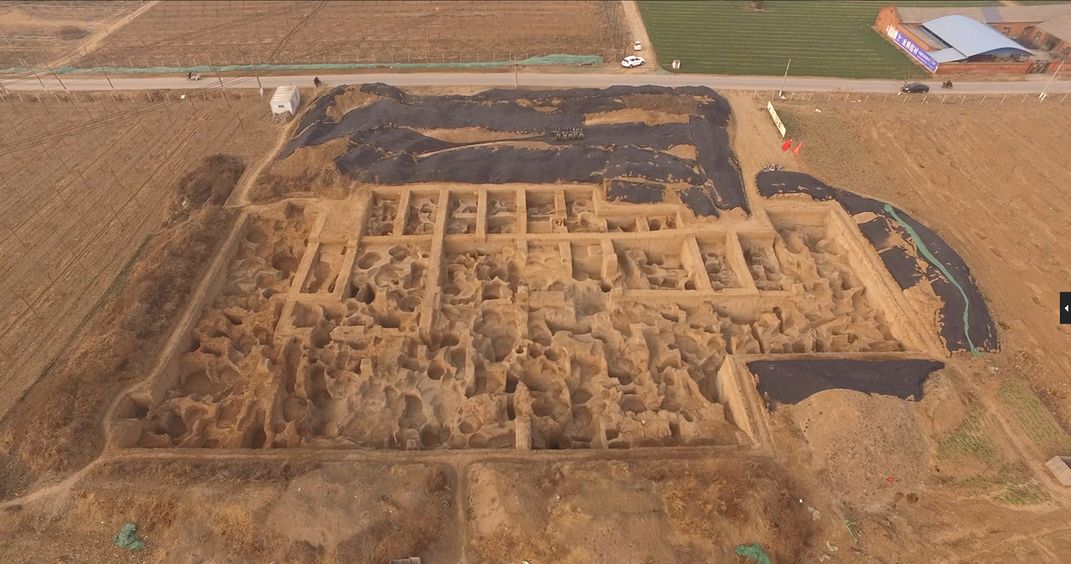World’s Oldest Known Coin Mint Found in China
The 2,600-year-old site produced highly standardized “spade money,” possibly on government orders
:focal(1085x710:1086x711)/https://tf-cmsv2-smithsonianmag-media.s3.amazonaws.com/filer/cd/c3/cdc35f2a-1898-4ea5-82b4-e79b4d108ce1/spade_coin_reconstruction.jpg)
Archaeologists in China have found what they say is the world’s oldest known coin manufacturing site. Used to make metal money around 2,600 years ago, the bronze casting workshop was located in the ancient city of Guanzhuang, in what’s now central China’s Henan Province, reports state-run news agency Xinhua.
During the dig, the researchers discovered finished coins, coin molds and pits dug for the disposal of casting waste. Using radiocarbon dating, they found that the workshop began minting operations between 640 and 550 B.C.E. The team published its findings in the journal Antiquity last week.
“The discovery of the coins is not surprising, but the discovery of a coin mint is truly exciting as it shows the existence of a very old coin workshop,” lead author Hao Zhao, an archaeologist at Zhengzhou University, tells China’s Red Star News, as reported by the Global Times.
Casting molds found at the site demonstrate that artisans took care to standardize the coins’ shape and size.
“[T]he clay cores were carefully made with the aid of a measuring tool to regulate their size and minimize variation,” the authors write.
The coins made at the workshop are “spade money,” an early form of metal currency shaped like the gardening tool of the same name. Per the Smithsonian’s National Museum of American History, these coins replaced cowrie shells during the Zhou dynasty’s Spring and Autumn Period, which lasted from about 770 to 476 B.C.E.

As Jesse Holth reports for ARTnews, the workshop itself began operations around 770 B.C., creating valuable bronze, ceramic, jade and bone artifacts before shifting focus to minting coins. The operation’s location close to the city’s administrative center suggests that it may have begun minting coins on government orders. Guanzhuang, founded around 800 B.C.E., appears to have been a center of activity in the Zheng State until its abandonment after 450 B.C.E.
Other foundries elsewhere in China began making coins around the same time. Per the Global Times, Zhao says previous excavations of two different coin mints from the Spring and Autumn Period took place before the development of technology that allows for precise carbon dating of minting materials.
The coins at the Guanzhuang site are not as old as metal coins discovered in the ancient city of Ephesus, in what’s now Turkey, but as Zhao points out, no coin mint has been found there.
Bill Maurer, an anthropologist at the University of California Irvine who was not involved in the new research, tells National Geographic’s Jillian Kramer that the discovery of the coins together with the molds used to make them is highly unusual. Ancient coins are often discovered in hoards far removed from the sites where they were minted, making it difficult to date them.
The new study adds fuel to a longstanding debate about the origins of currency. Some scholars argue that money began as a way to facilitate barter between merchants and customers. Others say governments created it to allow for the collection of taxes and debts.
Maurer tells National Geographic that the mint’s apparent standardization of coin production close to a political center “lends weight to the hypothesis that anthropologists and archaeologists have long held: that money emerges primarily as a political technology, not an economic technology.”
/https://tf-cmsv2-smithsonianmag-media.s3.amazonaws.com/accounts/headshot/Livia_lg_thumbnail.png)
/https://tf-cmsv2-smithsonianmag-media.s3.amazonaws.com/accounts/headshot/Livia_lg_thumbnail.png)